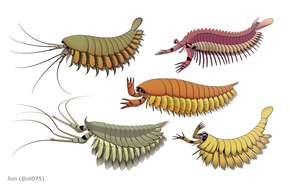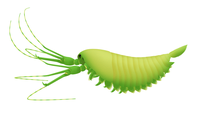Megacheira
| Megacheira Temporal range: Possible Silurian and Devonian records
| |
|---|---|

| |
| Alalcomenaeus (top left), Fortiforceps (top right), Haikoucaris (middle), Leanchoilia (bottom left) and Yohoia (bottom right). | |
| Scientific classification | |
| Domain: | Eukaryota |
| Kingdom: | Animalia |
| Phylum: | Arthropoda |
| Class: | †Megacheira Hou and Bergström, 1997 |
| Groups | |
| |
Megacheira ("great hands", also historically great appendage arthropods) is an extinct class of predatory
Morphology
Megacheirans are defined by their possession of
-
Life reconstruction of Fortiforceps (left) and Sklerolibyon (right)
-
Life restoration of Jianfengia
-
Closeup of great appendages of Leanchoilia superlata
-
Life restoration of Yawunik
Taxonomy
Several subdivisions within the group are recognised including Jianfengiidae (including
Relationship to other arthropods
Megacheirans are either suggested to be stem-group






